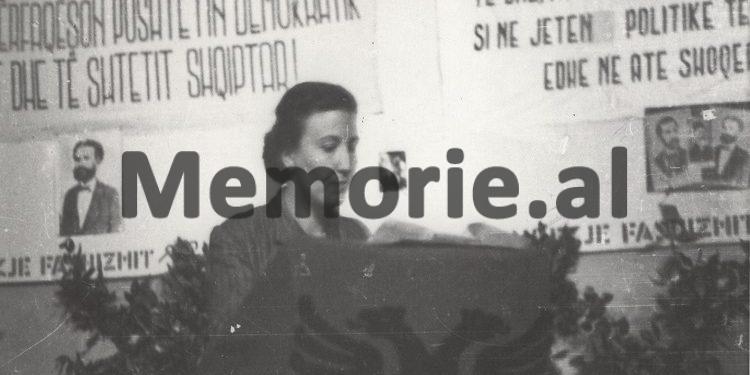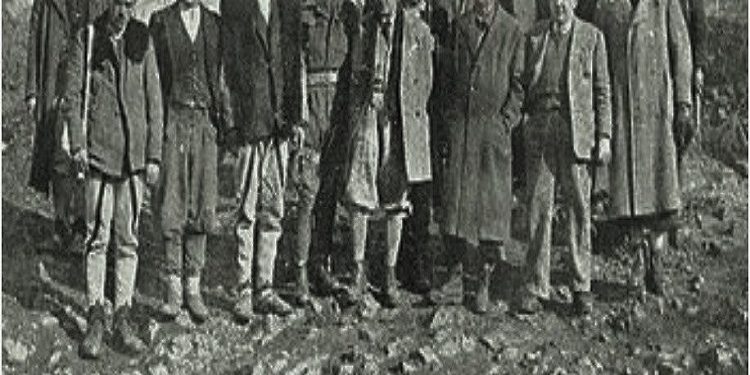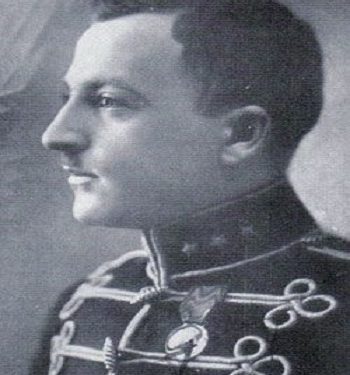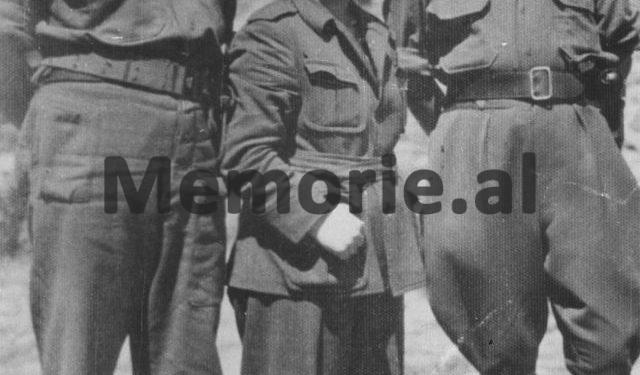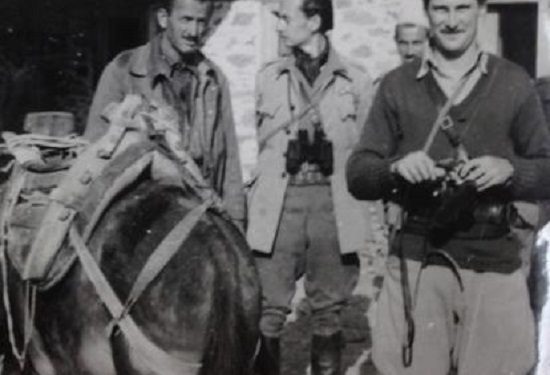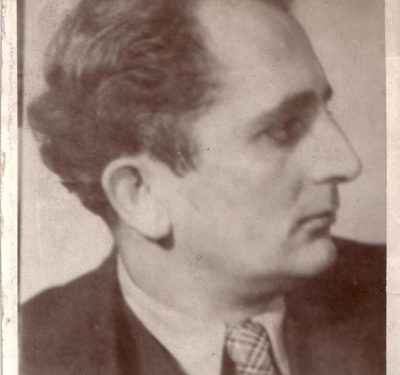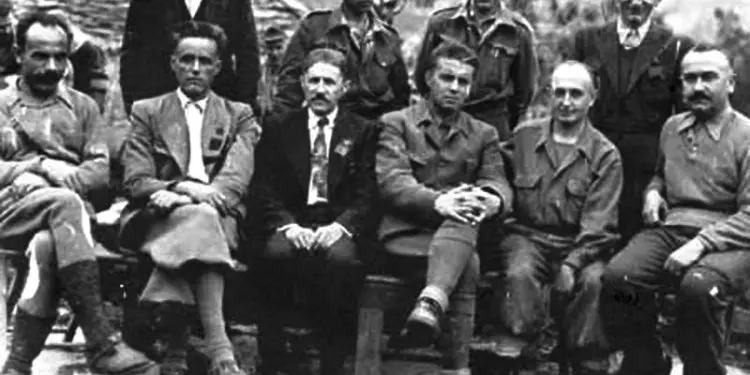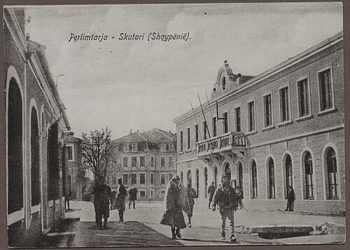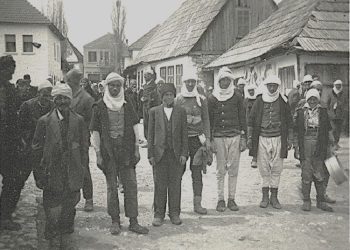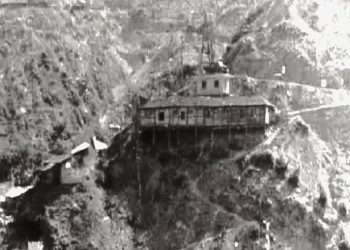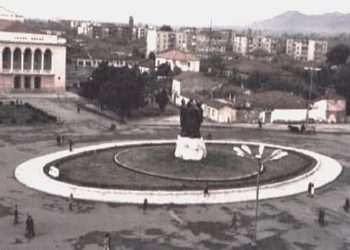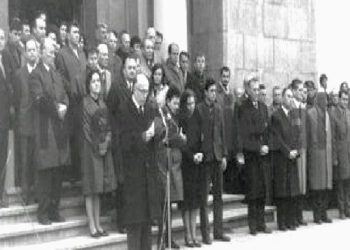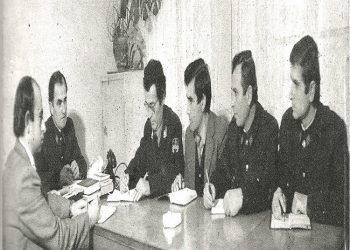From Dodë Progni
Second part
-The massacre of Herec – criminal act of the Yugoslav and Albanian communist leadership-
I – THE “KRYEZIU” MOVEMENT
Memorie.al / “Kryeziu Movement” was the name of the Nationalist Anti-Fascist Movement, in Kosovo and Northern Albania, during the years 1940 – 1944, at the head of which were the brothers from Gjakova, Gani, Said and Hasan Kryeziu. Its strategic goal was the organization of the Anti-Fascist Movement in Kosovo, its liberation from Nazi-fascists, separation from Serbia and union with the mother country, Albania. The Kryeziu brothers, like hardly anyone else in Albania at that time, had understood since the beginning of the Second World War that the most possible way to solve the Albanian national problem was to secure support from a great Western power, such as Britain e Madhe, and that such a thing could only be achieved by fighting against the Nazis.
During 1944, when the Kryeziu movement became a serious force in the Anti-Fascist War, in Northern Albania, the leadership of the Communist Party of Yugoslavia and that of the Albanian Communist Party did everything possible to eliminate it. The Yugoslavs could not accept the existence of such a force, outside of their control, which presented a real danger, for the explosion of a nationalist uprising in Kosovo, and therefore the danger of the secession of Kosovo from Serbia.
Nor did the Albanian side agree with such a nationalist force, which enjoyed the sympathy and support of the British allies. Its expansion and strengthening in Albania and Kosovo would endanger the establishment of communist power in Albania, which was the “Achilles’ heel” for the leadership of the KPK during the entire period of the War. In this regard, Peter Kemp explains that: “Such people were labeled to be destroyed by the new regime, as their combat activity refuted the claims of the communists that; only the Communist Party represented the Albanian people in the struggle for independence”.
These were the reasons that, “Enver Hoxha and Tito, as Reginald Hibbert asserts, had decided that it would be better not to have anti-fascist resistance in Kosovo than to have a movement led by Gani Kryeziu with Anglo-American support” .
The Albanian communist leadership worked on the tactic of gradual elimination of the Chiefs, since they were active participants in the Anti-Fascist War and could not be counted as collaborators of the Germans, to suppress them by force of arms. According to this tactic, the headquarters of the partisan forces operating in the Highlands of Gjakova, the “Bajram Curri” and “Perlat Rexhepi” battalions, the Kosmet headquarters, etc., asked the Kryezinjes to merge the nationalist forces with the partisan forces, unifying them under the command communist. Acceptance of this request would mean that the nationalist forces would eliminate themselves, so the Kryezini never accepted it. They were against the close ties that the Albanian communists had with the Serbs – Slavs, which would be an obstacle to the solution of the Kosovo issue. On the other hand, the introduction of Kryezinje under communist command would mean; the acceptance of a communist Albania, when peace came. The black leaders were for a democratic, Western-type republic.
In truth, the communists’ efforts for unification, although they were made in the name of the principles of the “Peza Conference”, were not sincere at all. Their opposition to the ‘Mukje Agreement’, August 1943, had made clear to anyone the negative attitude of the Albanian and Yugoslav communist leadership towards Albanian nationalism and the Kosovo problem. They did not aim at unification, for the benefit of the Anti-Fascist War, but at eliminating Kryeziu’s nationalist forces. This is what Reginald Hibbert affirms, in the book “Bitter Victory”, when he says: “Gani Kryeziu found obstacles from the partisans, who could not break for themselves, because of their ties with the Slavs. In case the partisans did not succeed, – he says, – they did not allow anyone to succeed in their place. From here, came the brazen sabotage of Kemp’s contacts with the Kryeziu brothers in December 1943 and January 1944.”
In these circumstances, the Blacks chose the middle path: that of cooperation against the invaders, of developing military actions, combined with the partisan forces, but without coming under the communist command. It is to the credit of both sides that not even the smallest armed conflict ever happened between Kryeziu’s forces and the partisan ones. In fact, among the communist leaders, the postulate: “O with us, o against us” crystallized more and more every day!
Despite the failed efforts to unify the partisan-communist forces with the nationalist ones of Kryeziu, such as the bilateral talks in the village of Markaj in Tropoja, on June 16, 1944, etc., the cooperation between them could be considered fruitful until the meeting of Valbona, on July 10-15, 1944, where about 400 people participated, representatives of all political and military groups that were operating at that time in the Highlands of Gjakova. Here, the communist leaders ultimately asked the Kryezins, together with the partisans, to attack the province of Plava, where the Albanian nationalist forces had taken up arms, in order to prevent the entry of the Slavic-communist partisan forces into the province.
More precisely, the Chiefs were asked to cooperate with the Yugoslav partisans, to suppress the Albanian nationalists of Plava. This ultimate and arrogant request of the communists, which put the Kryezini before the alternative: “Unification or final division”!, was not accepted by Gani Kryeziu. He not only rejected this anti-national request with indignation, but openly and emphatically declared that: “he would help the Albanian resistance fighters of Plava, if they would ask him for such a thing”.
The ultimatum of the communists, the result of the decisions of the Përmet Congress, May 24, 1944, which declared the communists in power, before the war was over. These decisions encouraged the communists to exercise dictation against political opponents, such as the Kryezini. Just one day after the meeting of Valbona, on July 16, 1944, the communists treacherously executed Father Lekë Lulin, former representative of the Legality Party at the Valbona meeting, because he had strongly opposed the pro-Slavic position of the communists, accusing them of National treason. This treacherous, criminal and extremely ugly act, which was carried out by the communists who had taken it upon themselves to escort P. Lekë Lulin from Valbona to Theth of Dukagjini, showed that all the opponents of their political, including the Kryezins, together with their movement.
Although faced with fierce opponents here and there across the border, the Blacks did not give up the anti-fascist war and the efforts to organize the anti-fascist uprising in Kosovo. In fact, at the beginning of August 1944, they, in cooperation with the British Major, Tony Simcox, drew up another detailed plan for the beginning of the uprising in Kosovo. Guided by this important objective, in August-September 1944, Kryeziu’s forces reached the highest level of organization and combat action, highlighting even better the talent and military leadership skills of commander Gani Kryeziu, the level the high political and organizational skills of Saidi, the bright and objective mind of Fundo, the bravery and skills of Hasan Kryeziu, Ali Brahim Zherka, Selim Malë Dula, Mehmet Ali Bajraktar, etc., who commanded these forces, in the field-battles against the Nazis- the fascists. During this period, the intensity of the fighting increased day by day.
Referring to the documents of that time, it appears that, on August 13, 1944, in the village of Çorraj e Lenič, of Bytyç, Gani Kryeziu’s detachments fought fierce battles against a detachment of the German army, which was forced to withdraw in the direction of the mineral area, after leaving several soldiers killed and wounded. A day later, on 14.08.1944, Kryeziu’s forces also fought in Zogaj village, against an SS company from Gjakova. Here too, there were several people killed and injured. Among them, two women killed and several men from the village arrested by the Germans, in the village of Çorraj in Bytyç. The size and intensity of the fighting, between Kryeziu’s forces and the German forces, in the second half of August 1944, is reflected even better in a report that the Kukës Gendarmerie Command sent to the superiors in Shkodër, Tirana and Kosovo, on 21.08.1944, where, among other things, it was said: “On the evening of August 19, the following actions were taken:
– The gang led by Hasan Kryeziu and Mehmet Bajraktari, consisting of 100 people, attacked the “Zog Mine”. -Ali Brahimi, with the partisans of Nikaj-Merturi, as well as those of Shala, who have been together for 120 years, has attacked the “Mines” located in the village of Kam. 3. – Selim Bajraktari and Bajram Uka with their squad attacked the “Kepenek Mine”. 4. – Gani Kryeziu with his squad consisting of approximately 400 people, happened to be in “Dobrej”, which has an English officer with him, as well as Llazar Fundon, also a radio transmitter…! The gangs are well armed, with automatic weapons and heavy machine guns…! The district ordered that, with the power at its disposal, with volunteers and with the German power located in its region, to take every measure to destroy and capture those squads”.
In front of Kryeziu’s forces, the German command and the Quisling governors were forced to act with several infantry detachments and collaborationist units, so-called “volunteers”, SS battalions and special regiments of the 21st German Mountain Corps, which were equipped with light and heavy armament, including armored vehicles, artillery and combat aviation.
Kryeziu’s nationalist forces stood out for bravery and heroism in the armed efforts against the Nazi fascists. In face-to-face battles with the enemy, the brave gave their lives: Rrustem Avdyl Mulosmani, Selim Bardhec Gjyriqi, Selim Ramë Mustafaj, Sokol Shpend Hoxhaj, Bajram Sylë Pepnikaj, Xhemal Sadri Abazi, Hazir Rrustem Osmani, Maxhun Zog Brahaj, Ibrahim Sylë Mustafaj, and Mehmet Ali Mehmetaj. etc. These, with their blood and life, wrote the brightest pages of the history of the Kryeziu Movement. These battles and the bloodshed in the efforts with the Nazi fascists, completely reject, as untrue, Enver Hoxha’s assertion that, allegedly, Kryeziu’s forces did not fight, but as he says, “they emptied some rifles into the hills, so to speak that we are fighting”.
In September 1944, the Bytyç – Gjakovë mineral area continued to be the scene of fierce fighting between Kryeziu’s forces and the German forces, which were forced to retreat towards Kosovo. On September 7, 1944, Kryeziu’s forces attacked the Babaj mine and freed 500 Montenegrin prisoners, who then joined the anti-fascist forces. On this same day, the Prefecture of Prizren informed the Ministry of Internal Affairs, in Tirana, that: “Gani Kryeziu, has the intention to join the Has and Luma detachments, with Kukës and cut off the Prizren-Shkodër traffic.”
From a report of the Command of the SS Division based in Gjakova, it appears that: “…Kryeziu’s forces were in control of the heights of Qafa e Prushi, from where they threatened Gjakova and had blocked the connections with the chrome mines”. While, on 14.09.’44, this same command claimed that, “…the forces of Kryeziu had attacked the city of Gjakova”. Even the Kukës Gendarmerie Command claimed that, on September 10 and 11, “Gani Kryeziu attacked the mines of Zogaj and headed for Gjakova, with the aim of attack…! The telephone line, Krumë – Qafë Prushi, was cut off by his forces, which also burned down the command post office of Qafë Prushi, the personnel of which joined Kryeziu’s forces.
The momentum of Kryeziu’s forces, from August 19 to September 19, 1944, with fierce and successful battles against the Germans in Kam, Kepenek, Zogaj, near Prushi, Babaj te Boka, Vogovë, Devë and Qerret, as well as the first strikes against of the German garrisons in Gjakova, led to the liberation of Bytyç and all of Tropoja, and marked the threshold of the general uprising in Kosovo.
It is difficult to say how the nationalist uprising, led by the Black Chiefs in Kosovo, would end. But we can affirm with conviction that the Kosovar nationalist insurgents, after the victory over fascism, would not lay down their arms without letting the signatories of the Atlantic Charter know that Kosovo was determined to win, even with blood, the right hers for self-determination. More precisely, the issue of Kosovo would be internationalized already at that time, questioning the Serbian rule over Kosovo.
Precisely, at this critical moment, very important for the fate of Kosovo and the Albanian nation, the hand of the Albanian communist leadership, which could not endure any longer, a successful nationalist force in the Anti-Fascist War, which enjoyed the sympathy of British support, such as the Kryeziu Movement? Particularly worrying for the Albanian communist leadership was the order of the British Foreign Minister, Anton Iden, given to the resident minister of England in Cozerta, Italy, where, among other things, it was said: “Enver Hoxha, let us know that, when the time comes for the recognition of his government, it should be advised to accept in the National-Liberation Front, such persons as the Kryeziu brothers, who have given proof of anti-fascist struggle and patriotism”.
In fact, this order was a direct pressure on Enver Hoxha, to limit the absolute power of the communists, which was being established in Albania. It openly showed that a monist government, with only communists, that Enver Hoxha had designed, was not liked and would never be supported by the British and other Western allies. Enver Hoxha, alarmed, but always in cooperation with the Yugoslavs, ran to be the first to annihilate the Kryezins and the nationalist forces they commanded. In the radiogram sent to Liri Gegë, dated August 8, 1944, Enver Hoxha instructed: “Next to Kryeziu, there is Zai Fundo. A month ago, Fadil Hoxha talked with Kosmet’s friends. Dushani and Rade also know…! I told Fadil to kill him (Zai Fundon – D.P), regardless of any circumstances”.
Meanwhile, on September 10, 1944, Enver Hoxha sent an “extremely conspiratorial” letter to the Headquarters of the First Corps of the UNCL, where, among other things, he emphasized: “The British are becoming godfathers for the union of the reaction of Kosovo, with our traitors under the flag of any Gani Kryeziu, or of any government that could eventually form…! Our task is to destroy the reaction militarily…! No longer ask Gani to surrender, but at all costs and fiercely, attack and kill. You must act as soon as possible, so that Kosovars can come to their aid – he added”.
Also, the secretary of the Yugoslav Communist Party’s committee for Kosovo and member of the UNJ Operational Staff, Pavle Jovičeviči (“Rade”) instructed Fadil Hoxha to very secretly verify the information that; where exactly was Gani Begu, how many forces he had, where were the battalions, was the road guarded, etc. “This is strictly conspiratorial. Announce at 5.30 and 10″ – Pavle”.
On September 19, 1944, Enver Hoxha sends Shefqet Peçi with his Brigade to Bytyç, who, after climbing Dobrej mountain, where the Kryezin headquarters was, arrest Said Kryeziu, Zoi Fundo and the English major, Tony Simcox, who they leave for the city of Berat, where the UNCLSH General Headquarters and Enver Hoxha were located. Major Simcox and Said Kryeziu, after the determined intervention of the English, were allowed to leave for Italy. Whereas Llazar Fundon, after being arrested, tortured him to death and asked him to answer the questions sent by Enver Hoxha via radiogram:
“Zai Fundon tortures him to death and then shoots him there. He should be asked to answer these questions: Why did he come to Kosovo, who sent him, and with what directives? What are the goals of Gani and the English? To give clarifications about the previous activity and about his betrayal. Send Zai’s depositions to us here, kill Zai there…”! Thus, of all the participants in the ‘Kryeziu Movement’, the first to be executed, even in an animalistic way and by special order of Enver Hoxha, was Zai Fundo”.
The brutal murder of Fundo, as R. Hibbert pointed out in the book “Bitter Victory” – was evidence of the unacceptable nature of partisan power… it was a case of communism devouring its own: this was a liquidation between comrades, or in this case, former friends”. The events of September 19, 1944, were the worst and most flagrant provocation that the Albanian communist leadership had done to Kryeziu’s forces until then. It, by the personal order of Enver Hoxha, as it had done with other nationalist groups, was imposed by force of arms on the ‘Kryeziu Movement’, eliminating its political leadership and British support. In fact, this brutal, treacherous and anti-national action was the devastating blow, not only for the Kryeziu Movement, but also for the nationalist anti-fascist uprising in Kosovo. Memorie.al
The next issue follows




